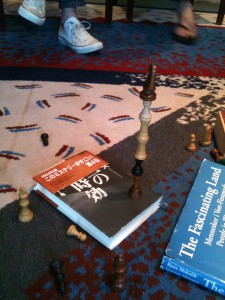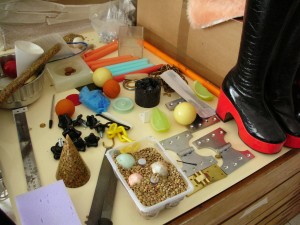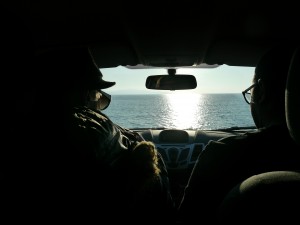LE PALAIS DE TOKYO
plays
EFFERVESCENCE
with
Hélène Meisel
Elsewhere and later
On the benefits of deferred production
Since 2002, the Palais de Tokyo has been an unusual centre d’art in the heart of Paris. In addition to its exhibition programme, it houses the Pavillon Neuflize OBC, a residence that accommodates ten international artists or curators each year. Hélène Meisel, curator-in-residence in 2012, recalls the challenges of production and research in this context, which she wishes to be completely free of subordination to any results-oriented policy.
Taking the form of a research laboratory, the Pavillon is one of those hybrid residences – collective, long, distended and ubiquitous – which set the opportunistic “here and now” principle aside in favor of delays and disorientating episodes more conducive to different kinds of gestation. Given mature consideration over a long period by the artist Ange Leccia and finally initiated in 2001 in accordance with a forward-looking and experimental attitude accepting “roaming as an experience in its own right”, in 2010 the residence declared that “a creative laboratory implies the absence of any objective, result and end-purpose” 1. Therefore the Pavillon still adheres to the principle of offering hospitality without expecting a return, that means with no obligation to produce. Every year for eight months, around ten young artists (infiltrated by one or two curators or critics) form an undertaking with variable geometry, authorized to engage in various reconnaissance and intervention operations. The Pavillon gravitates round the Palais de Tokyo, like a satellite, alternately stealthy and fully visible.
 While it is indeed the “place of shelter” its name – in the sense of pavilion – implies, the Pavillon – in its meaning as flag – is also the signal given remotely – the sound signal that the ear traps in the convolutions of its pavilion (or pinna); the floating flags that ships used to hoist to announce the general situation on board, with no further details. On a notice at the entrance of the big studio-office recently cleared from the roof at the heart of the Palais de Tokyo, the message “Pavillon at work, please look round” chimes with the elliptical urgency of the maritime signals. I want to communicate with you or I invite you to transmit. I am in distress, communicate with me. My ship is germ-free, I request free pratique. Now transmitting now receiving, the Pavillon alternates recordings and reproductions, sometimes keeping the distance necessary for its research. Obscure from the outside, its activity is not always more immediately clear from within. Moreover, with reference to the Ateliers Internationaux [International Workshops] residence created in 1983 at the Frac of the Pays de la Loire which he then ran, Jean de Loisy maintained that “the change of mindset that collective momentum ought to lead to might not produce a result until five years later: immediacy not [being] indispensable” 2. So what is this submerged part of the Pavillon which by dint of dissemination (travel, interdisciplinarity) might seem to obey a strategy of backsliding?
While it is indeed the “place of shelter” its name – in the sense of pavilion – implies, the Pavillon – in its meaning as flag – is also the signal given remotely – the sound signal that the ear traps in the convolutions of its pavilion (or pinna); the floating flags that ships used to hoist to announce the general situation on board, with no further details. On a notice at the entrance of the big studio-office recently cleared from the roof at the heart of the Palais de Tokyo, the message “Pavillon at work, please look round” chimes with the elliptical urgency of the maritime signals. I want to communicate with you or I invite you to transmit. I am in distress, communicate with me. My ship is germ-free, I request free pratique. Now transmitting now receiving, the Pavillon alternates recordings and reproductions, sometimes keeping the distance necessary for its research. Obscure from the outside, its activity is not always more immediately clear from within. Moreover, with reference to the Ateliers Internationaux [International Workshops] residence created in 1983 at the Frac of the Pays de la Loire which he then ran, Jean de Loisy maintained that “the change of mindset that collective momentum ought to lead to might not produce a result until five years later: immediacy not [being] indispensable” 2. So what is this submerged part of the Pavillon which by dint of dissemination (travel, interdisciplinarity) might seem to obey a strategy of backsliding?
Applications papers, expressions of interest, action memoranda, invitations to tender, communiqués, etc.: an incomplete list of the deadlines that sometimes speed up the formulation of a work even before its conception has fully matured. Communication imperatives that therefore put pressure on priorities to the point of inverting them, like the habit of printing catalogues before the exhibition they ought to relate to has itself been hung. The ability to write newsletters, supply material to a website or record his/her latest activities on social networks transfers to the artist the skills of the press officer or the gallery owner that s/he does not (or does not yet) have, wrongly putting on to his/her shoulders the professionalism of communicators. Without wanting to feed the mythology of the artist who refuses to speak or that of the work that defies description, this remark gives rise to certain aberrant pathways: the caricatural one of invasive (self-)promotion, sometimes infused with the means adopted by reality TV shows 3, coaching or personal development : “Expanding your visibility as an artist”, advice directed toward “profitable & entrepreneurial artists” 4; or again the route of aberrant accelerations, rushing the work to the point of making it start at its actual destination, its exhibition or publication. In 1972, irritated by the takeover of documenta 5 by the curator Harald Szeemann, Daniel Buren regretted that “the artist casts himself and his work into this snare, because the artist and his work, impotent through the habit of art, can no longer do anything other than allow someone else to exhibit: the organizer” 5. Likewise in 1980 Catherine Millet showed foresight in dreading this “McLuhanesque situation” meaning that “it is sometimes the structures of distribution that give art its content” 6. Countering these contagious rhythms, the artist should be able to enjoy a right to hold back, authorizing him or her if not not to produce, at least not to produce straight away: restating the perhaps obsolete moral right, namely the right to divulge. Let us not cite (or if we do, out of pretension) Artistes sans œuvres 7, the Bartlebys who “would prefer not to” 8, or those who prevent overproduction, heirs to the Droit à la paresse (Right to be lazy) 9… For between the dandy’s inertia and the claims of the proletariat, the artist subscribes to an economy that is peculiar to him/her, and goes beyond mere financing packages. The production of a work, of course, is not simply its budgetary estimate, the ratio between positive expenditure (needs) and negative expenditure (sacrifices). It is firstly the evaluation of its necessity.
Paradoxically, it is necessary to have the means – financial and theoretical – not to produce, i.e. it is necessary to be able to take on board the lack (to be gained) that the absence of any work can generate, even if in the absence of any object there can of course be the no less remunerative transaction of a certificate, a report, or some sort of trace. Far from concluding that solely a well-to-do minority has the monopoly of non-production, it is indeed necessary to envisage that this is a charge on a category of less affluent artists, who are nonetheless determined not to produce more in order to earn more. The Pavillon organizes periods of intense stimulation, and often generates “double-vision” thinking which follows its course in each individual, whether here or there. There are many opportunities to pay tribute to geographical extremes, to sublime or desolate beauty
, to the social and political context, to the skills encountered, to artists’ sanctuaries, to experiences undergone, and above all situations provoked. However, the moments that have made the deepest mark on me in the context of the residence in 2012 will have a disappointing dimension: nothing heroic or exotic in those discussions that took place in Paris or on the move, allowed by the intimacy of the group (or the groups within the group), during which on several occasions I saw a work taking shape and dematerializing. The way in which, between seriousness and mockery, repetitions were kept track of, wrong trails were defused, and mannerisms countered. Purges experienced as liberations, revealing a question which had never appeared to me so clearly: Is the work the survivor of contingent options set aside before it, of which it is the negative sum? The consequence of a feeling of discretion, mixed with intuition and supremacy, which the possibility of “successful mistakes” 10preserves from paralysis. However, “productivity without an object” 11is not the end purpose of the raising of such questions, which means to go beyond reflexivity without reveling in doing so. As a cell of doubt and contradiction, the Pavillon offers the possibility of collective resolution as well as of opinionated isolation.
 The residence is elusive, opting for delocalized and sometimes underwater activity, less through a liking for mystery than through trust in the unforeseeable. Moreover, the title Claude Closky recently gave to the tenth anniversary exhibition of the Pavillon This & there in English, Ça & là in French, conveyed a form of ubiquity verging on scattering. While the majority of residences are characterized by being anchored in a context and reacting to a setting (logically in situ), the Pavillon opts for an itinerant approach, now nomadic, now roaming. Thus the journeys undertaken each year by the different year groups at the Pavillon do not set out (not always, or not only) to be pretexts for an inspiring sense of foreignness or study-related tourism. The Mekong Delta, the Arctic Circle or Tierra del Fuego: it is rather a matter of collective disorientation, or even collective dispossession. Initially, moreover, the journey will not involve movement. The residents’ different languages, all striving toward English, herald the exhilaration of translation processes to come, full of extrapolations and failures of understanding. Hence the first form to occur collectively is discussion: simultaneous translations, collegiate presentations, circumscribed, circumspect debates, sporadic exchanges, private conversations with unforeseeable results, hypotheses, wagers, ramblings… The spoken word with its variable plasticity, the roundness of which can roll toward consensuses with no way out, while hitches in it can lead to productive disagreements. For it is often a matter of working on a common project together – a performance, exhibition, film shoot, etc. – where negotiations ought not to give way to compromise, but the free circulation of ideas tends to blur any localized authorial voice. When discussion is prolonged to an extreme point, it can sometimes seem gratuitous or navel-gazing, purely symbolical. However, in its very exhaustion, it also recharges the levers of the salutary process of “going into action”: resulting in a production completed elsewhere, and later.
The residence is elusive, opting for delocalized and sometimes underwater activity, less through a liking for mystery than through trust in the unforeseeable. Moreover, the title Claude Closky recently gave to the tenth anniversary exhibition of the Pavillon This & there in English, Ça & là in French, conveyed a form of ubiquity verging on scattering. While the majority of residences are characterized by being anchored in a context and reacting to a setting (logically in situ), the Pavillon opts for an itinerant approach, now nomadic, now roaming. Thus the journeys undertaken each year by the different year groups at the Pavillon do not set out (not always, or not only) to be pretexts for an inspiring sense of foreignness or study-related tourism. The Mekong Delta, the Arctic Circle or Tierra del Fuego: it is rather a matter of collective disorientation, or even collective dispossession. Initially, moreover, the journey will not involve movement. The residents’ different languages, all striving toward English, herald the exhilaration of translation processes to come, full of extrapolations and failures of understanding. Hence the first form to occur collectively is discussion: simultaneous translations, collegiate presentations, circumscribed, circumspect debates, sporadic exchanges, private conversations with unforeseeable results, hypotheses, wagers, ramblings… The spoken word with its variable plasticity, the roundness of which can roll toward consensuses with no way out, while hitches in it can lead to productive disagreements. For it is often a matter of working on a common project together – a performance, exhibition, film shoot, etc. – where negotiations ought not to give way to compromise, but the free circulation of ideas tends to blur any localized authorial voice. When discussion is prolonged to an extreme point, it can sometimes seem gratuitous or navel-gazing, purely symbolical. However, in its very exhaustion, it also recharges the levers of the salutary process of “going into action”: resulting in a production completed elsewhere, and later.
Further reading:
Palais de Tokyo
Le Pavillon
Notes:
- 196 résidences en France, Centre National des Arts Plastiques, 2010, p. 62. ↩
- Jean de Loisy, 6 séquences : Ateliers internationaux du FRAC des Pays de la Loire : chroniques et perspectives 1984 – 2007, Carquefou, FRAC des Pays de la Loire, 2007, p. 192. ↩
- Some examples of attempts at artistic TV reality: Work of art : the next great artist (Bravo TV), The School of Saatchi (BBC2), or the “TV master class” Tous pour l’art (Arte). And as a counterpoint, the self-produced parody Residence story / The Artist, the Survivor, and of course the works of Ryan Trecartin or younger artists like Arnaud Dezoteux. ↩
- See The Profitable Artist: A Handbook for All Artists in the Performing, Literary, and Visual Arts, New York, Artspire, Allworth Press and The New York Foundation for the Arts, 2011. ↩
- Daniel Buren, Exposition d’une exposition, in Documenta 5: Befragung der Realität, Bildwelten heute, exh. cat. [Kassel, Neue Galerie Schöne Aussicht, Museum Fridericianum Friedrichsplatz, June 30 – Oct. 8, 1972], Kassel, Documenta, 1972. ↩
- Catherine Millet, “Le service des renseignements artistiques”, in 11e Biennale de Paris : manifestation internationale des jeunes artistes, exh. cat. [Paris, Musée d’Art Moderne de la Ville de Paris, Centre Georges Pompidou, Sept. 20 – Nov. 2, 1980], Paris, 1980. ↩
- Jean-Yves Jouannais, Artistes sans œuvres, I would prefer not to, Paris, Hazan, 1997. ↩
- Hermann Melville, “Bartleby, the Scrivener, A Story of Wall Street” (1853): a short story about a paid employee, undertaking to copy out legal documents, and refusing any other request with a pleasant “I would prefer not to”. ↩
- Paul Lafargue, Droit à la paresse, réfutation du droit au travail de 1848, 1880. ↩
- “Chaque livre comme chaque écrivain a un passage difficile, incontournable. Et il doit prendre la décision de laisser cette erreur dans le livre pour qu’il reste un vrai livre, pas menti. […] Il y a aussi les erreurs des auteurs, des choses comme ça qui sont en fait des chances. C’est très enthousiasmant les erreurs réussies […]” {Every book and every writer has a difficult passage that cannot be ignored. And he must take the decision to leave that mistake in the book so that it remains a true book, not a lying one. […] There are also mistakes by authors, things like that which are in fact opportunities. Successful mistakes generate great enthusiasm […]} Marguerite Duras, Ecrire, Paris, Gallimard, Folio, 1993, pp. 34-35 ↩
- See the pessimism of Hito Steyerl and Boris Buden regarding the substitution of production by the art of feeding the network in “L’artiste rés(iden)t”, “Ce n’est qu’en nous autorisant à envisager le point de vue du reste, que nous pourrons comprendre que la vacuité de la mise en réseau et la productivité sans objet sont en fait le rouage d’une idéologie démente de créativité tournant à vide” [It is only in allowing ourselves to envisage the point of view of the remainder that we will be able to understand that the vacuity of posting on the net and productivity without an object are in fact the mechanism of a demented ideology of creativity running on empty] in 6 séquences : Ateliers internationaux du FRAC des Pays de la Loire : chroniques et perspectives 1984 – 2007, Carquefou, FRAC des Pays de la Loire, 2007, p. 192. ↩


